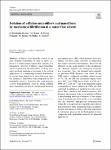Thông tin tài liệu
Thông tin siêu dữ liệu biểu ghi
| Trường DC | Giá trị | Ngôn ngữ |
|---|---|---|
| dc.contributor.author | E., Hernández-Becerra | - |
| dc.contributor.author | M., Osorio | - |
| dc.contributor.author | D., Marín | - |
| dc.date.accessioned | 2023-04-21T07:03:21Z | - |
| dc.date.available | 2023-04-21T07:03:21Z | - |
| dc.date.issued | 2023 | - |
| dc.identifier.uri | https://link.springer.com/article/10.1007/s10570-023-05162-3 | - |
| dc.identifier.uri | https://dlib.phenikaa-uni.edu.vn/handle/PNK/8214 | - |
| dc.description | CC BY | vi |
| dc.description.abstract | Cellulose from vegetable sources is the most abundant biopolymer on earth. In plants, cellulose is a reinforcement element that conforms to a hierarchical structure. Cellulose micro-/nanofibers can be isolated from the cell wall by top-down strategies involving mechanical processes to be used in applications as a reinforcing material. Nonetheless, its use has been limited as its extraction in an aqueous medium is unfavorable when employed in low-hydrophilic matrices. | vi |
| dc.language.iso | en | vi |
| dc.publisher | Springer | vi |
| dc.subject | cellulose microfibers | vi |
| dc.title | Isolation of cellulose microfibers and nanofibers by mechanical fibrillation in a water-free solvent | vi |
| dc.type | Book | vi |
| Bộ sưu tập | ||
| OER - Khoa học Tự nhiên | ||
Danh sách tệp tin đính kèm:

